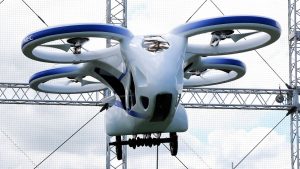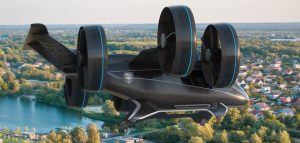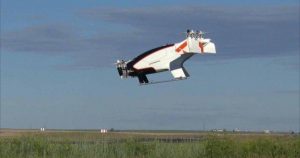
Shownotes
Welcome to Day 1468 of our Wisdom-Trek, and thank you for joining me.
This is Guthrie Chamberlain, Your Guide to Wisdom
Flying Cars and Aerial Ridesharing – Ask Gramps
Wisdom - the final frontier to true knowledge. Welcome to Wisdom-Trek! Where our mission is to create a legacy of wisdom, to seek out discernment and insights, to boldly grow where few have chosen to grow before. Hello, my friend, I am Guthrie Chamberlain, your captain on our journey to increase Wisdom and Create a Living Legacy. Thank you for joining us today as we explore wisdom on our 2nd millennium of podcasts. Today is Day 1468 of our Trek, and our focus on Fridays is the future technological and societal advances, so we call it Futuristic Fridays. My personality is one that has always been very future-oriented. Since my childhood, I have yearned for the exploration and discovery of new technologies and advancements for the future. I grew up with the original Star Trek series, and even today, as I am now on my 65th revolution around the sun, I still dream of traveling in space. Each week we will explore rapidly converging technologies and advancements, which will radically change our lives. At times, the topics may sound like something out of a science fiction novel, but each area that we explore is already well on its way of becoming a reality over the next couple of decades.
To keep with our theme of “Ask Gramps,” I will put our weekly topics in the form of a question to get us on track. So this week’s question is, Hey Gramps, I have been dreaming about flying cars since the Jetson’s cartoon was released in 1962. It was supposedly set in the year 2062. Do you think we will have flying cars by then, and how will that change car ownership?
Flying Cars And Aerial Ridesharing
Last week we focused on how Virtual Reality will change everyday life and work. This week we jump into transportation and explore flying cars. I am using some of the information mentioned in Peter Diamandis’s blogs and book “The Future is Faster Than You Think.”
In 2019, for the seventh straight year, Los Angeles earned the dubious honor of being the most gridlocked metropolis in the world, where the average driver spends 2.5 working weeks per year trapped in traffic.
Countless cities are close behind. For the average driver, dreams of being elevated above jammed freeways and flying—uninterrupted—to one’s destination seem well out of reach. Yet these visions will soon become realities.
The era of the internal combustion engine car will gradually end. From here on out, the focus will be on electric vehicles, autonomous ridesharing, and flying fleets. The implications for society and the automotive industry are HUGE.
Death of Car Ownership
During this decade, we will reach a peak for the manufacturing of internal combustion engines. That may sound somewhat premature, but oil demand for transportation is predicted to peak as early as 2025, according to Bloomberg New Energy Finance, and some experts suggest it may have already peaked.
Currently, electric vehicles or EVs displace the need for 350,000 barrels of oil each day. Long term, EVs are projected to disrupt demand of over 58,000,000 barrels of oil per day by the end of the decade, a figure steadily on the rise as EV costs plummet.
Speeding to first place in today’s transit race, EVs are set to win by sheer economic advantage, fast becoming the foundation for autonomous ridesharing fleets of the future. As that happens, it will soon become un-economical and socially unacceptable for you to hold on to that old gas-guzzling car, at least in major metropolitan areas. Next, we will see electric vehicles migrating to the skies in the form of flying vehicles. By mid-2018, over $1 billion had been invested by startups, VCs, and aerospace giants in at least twenty-five different flying car companies. A dozen vehicles are being test-flown, while another dozen are at stages ranging from PowerPoint to prototype.
Next, we will see electric vehicles migrating to the skies in the form of flying vehicles. By mid-2018, over $1 billion had been invested by startups, VCs, and aerospace giants in at least twenty-five different flying car companies. A dozen vehicles are being test-flown, while another dozen are at stages ranging from PowerPoint to prototype.
Let’s explore the next era of transportation and what will change.
The Hardware is Here
In 2019, Uber hosted its third annual flying car conference, Uber Elevate, in Washington, D.C. The event attracted a motley crew of power elites: CEOs, entrepreneurs, architects, designers, technologists, venture capitalists, government officials, and real estate magnates. Over a thousand in total, all gathered to witness the birth of a new industry.
Jeff Holden, Uber’s (former) Chief Product Officer, initiated the conference with quite a vision. This is what he said.
“We’ve come to accept extreme congestion as part of our lives,” says Holden. “In the U.S., we have the honor of being home to ten of the world’s twenty-five most congested cities, costing us approximately $300 billion in lost income and productivity.”
Uber aims to solve urban mobility by offering “aerial ridesharing” solutions, taking advantage of untapped air space just as New York City scaled buildings to the skies to combat increasing congestion on the ground.
Aerial ridesharing might sound like a sci-fi cliché, but Holden has a solid track record of disruptive innovation. In the late 1990s, he followed Jeff Bezos from New York to Seattle and became one of the earliest employees at Amazon, where he spearheaded Amazon Prime.
Next, Holden went to another disruptive startup, Groupon, and then on to Uber, where he’s strung together a series of wins: UberPool, UberEats, and, most recently and radically, Uber’s self-driving car program.
So when Holden proposed an even zanier product line—that Uber aerial ridesharing — what followed was no surprise: the company’s leadership, as well as everybody else, took him seriously.
There is a good reason for this. The theme of the Uber Elevate Summit isn’t actually about flying cars. The cars are already here. Instead, the focus was the path to scale—the more critical point: that path is a lot shorter than many suspect.
As of 2018, over twenty-five different flying car startups have secured upwards of $1 billion in aggregate funding. Larry Page, co-founder, and CEO of Alphabet-Google was among the first to envision the Electric Vertical Take-Off and Landing vehicle potential, personally funding two companies, Zee-Arrow and Kittyhawk.
Then there are established players like Boeing, Airbus, Embraer, and Bell Helicopter (now just called ‘Bell,’ a reference to the future disappearance of the helicopter itself). They are also in the game. Thus, for the first time in history, we’re past the point of talking about the possibility of flying cars. The cars are here.
Car Ownership Becomes Economically Irrational
“Uber’s goal,” according to Holden, “is to demonstrate flying car capability in 2021 and have aerial ridesharing fully operational in Dallas and LA by 2025.” He goes even further: “Ultimately, we want to make it economically irrational to own and use a car.” How irrational? Let’s look at the numbers.
Today, the marginal cost of car ownership—that is, not the purchase price, but everything else that goes with a car: gas, repairs, insurance, parking, etc.—is 49 cents per passenger mile. For comparison, a helicopter, which has many more problems than just cost, covers a mile for about $8.93.
For their 2021 launch, UberAir wants to reduce that per-mile price to $5.73, then rapidly drive it down to $1.84. But it’s Uber’s long-term target that’s the game-changer—44 cents per mile—or cheaper than the cost of driving.
You get a lot per mile. The specs for Uber’s proposed service are impressive. Their primary interest is in “electric vertical take-off and landing vehicles”—or eVTOLs for short. For an eVTOL to qualify for Uber’s aerial ridesharing program, it must be able to carry one pilot and four passengers at a speed of over 150 mph for three continuous hours of operation.
For an eVTOL to qualify for Uber’s aerial ridesharing program, it must be able to carry one pilot and four passengers at a speed of over 150 mph for three continuous hours of operation.
While they envision 25 miles as their shortest flight (think Malibu to downtown Los Angeles), these requirements allow you to leap from northern San Diego to southern San Francisco in a single bound. Uber now boasts five partners who have committed to delivering eVTOLs that meet these specs, with another five or ten still to come.
Aerial Freeways
But the vehicles alone don’t make car ownership irrational. So Uber has also partnered with NASA and the FAA to develop the air traffic management system to coordinate their flying fleet.
Beyond government players, Uber has additionally teamed up with architects, designers, and real estate developers to create a string of “mega-skyports” needed for passengers to load and unload and for vehicles to take off and land.
To qualify as Uber-ready, a “mega-skyport” must be able to recharge vehicles, handle 1,000 take-offs and landings per hour (4,000 passengers) and occupy no more than three acres of land—which is small enough to sit atop old parking garages or the roofs of skyscrapers.
And according to Uber’s calculations, a network 40 skyports strong, positioned strategically around a city, should be able to clear a million passengers an hour.

Implications
Put all this together, and by 2030 or shortly after that, you’ll be able to order an on-demand aerial rideshare as easily as you do UberRide, UberPool, or UberEats. If a century’s worth of transportation adoption rates are to be trusted, urban aviation could be a central mode of getting from A to B in a mere decade.
All of this raises a fundamental question: Why now? After dreaming since “The Jetson’s” in 1962, and then Blade Runner hover cars and Back to the Future DeLorean DMC-12s for several decades, how will we be able to accomplish this mission within the next decade?
There are over a hundred different patents on file in the U.S. for “roadable aircraft.” A handful have flown. Most have not. None have delivered on the promise of the Jetsons.
Our frustration at this lack of delivery has become a meme unto itself. At the turn of the last century, in a now-famous IBM commercial, comedian Avery Johnson asked: “It’s the year 2000, but where are the flying cars? I was promised flying cars. I don’t see any flying cars. Why? Why? Why?”
In 2011, in Peter Thiel’s now-famous manifesto, “What Happened To The Future,” the prominent investor echoed this concern, writing: “We wanted flying cars; instead we got 140 characters.” Yet, as should be clear by now, the wait is over.
The Cars Are Here, and we are rapidly developing them to the point of being economically feasible and accessible to much of the population. The infrastructure is coming fast also. While we were sipping our lattes and checking our Instagram, science fiction became science fact.
As Christ-followers, all of the new technology can and should be a means to further God’s kingdom here on earth as we fill His high-calling. Just like commercial air-travel changed our ability to reach millions with the Gospel of Christ, so will each new technological breakthrough extend our reach. Personal flying vehicles will is yet another tool.
Oh, that I had wings like a dove; then I would fly away and rest!
That is a wrap for today’s question. Join us again next Futuristic Friday as we look at AI, Robots, and Drones on our ‘Ask Gramps’ episode. Our next trek is Meditation Monday, where we will help you reflect on what is most important in life. So encourage your friends and family to join us and then come along on Monday for another day of ‘Wisdom-Trek, Creating a Legacy.’ If you would like to listen to any of the past 1467 daily treks or read the associated journals, they are all available at Wisdom-Trek.com. I encourage you to subscribe to Wisdom-Trek on your favorite podcast player so that each day will be downloaded to you automatically.
If you would like to listen to any of the past 1467 daily treks or read the associated journals, they are all available at Wisdom-Trek.com. I encourage you to subscribe to Wisdom-Trek on your favorite podcast player so that each day will be downloaded to you automatically.
Thank you for allowing me to be your guide, mentor, and, most of all, your friend as I serve you in through this Wisdom-Trek podcast and journal.
As we take this Trek of life together, let us always:
- Live Abundantly (Fully)
- Love Unconditionally
- Listen Intentionally
- Learn Continuously
- Lend to others Generously
- Lead with Integrity
- Leave a Living Legacy Each Day
I am Guthrie Chamberlain….reminding you to ’Keep Moving Forward,’ ‘Enjoy your Journey,’ and ‘Create a Great Day…Everyday’! See you on Monday!